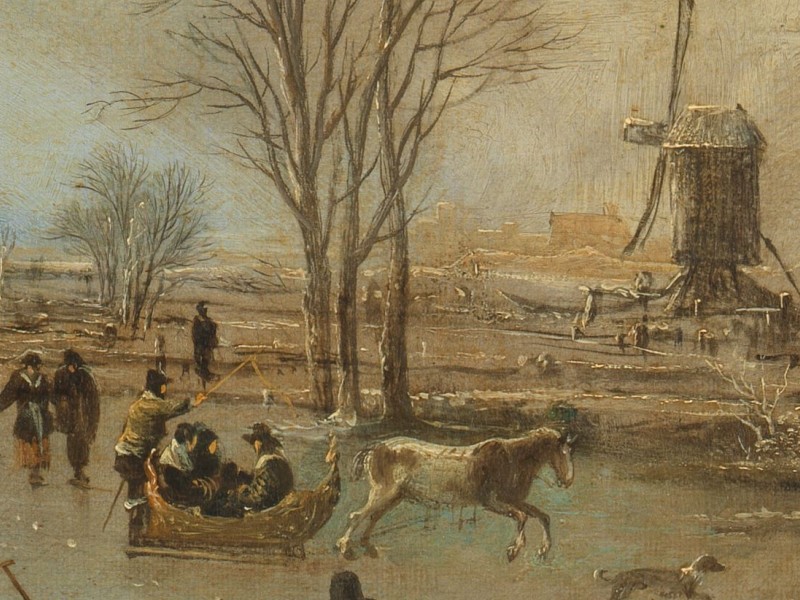
“It was late in the day when we carried on with our journey. We still had two miles to go, and the road was terrible. When we tried to cross a wide ditch, the ice broke and two of our horses with their sledge fell into the water.”1
From Helsingborg to Jönköping
9 February – 12 February 1586
Samuel Kiechel had left Copenhagen and was on his way to Stockholm. He had met two merchants from Hamburg who had their businesses in the Swedish capital, and together, they travelled to Helsingør and crossed the Øresund, the most important and, for the Danish crown, the most lucrative access to the Baltic Sea. The three men had lunch in Helsingborg, located on the opposite side of the Sound, and afterwards, they searched for transportation.
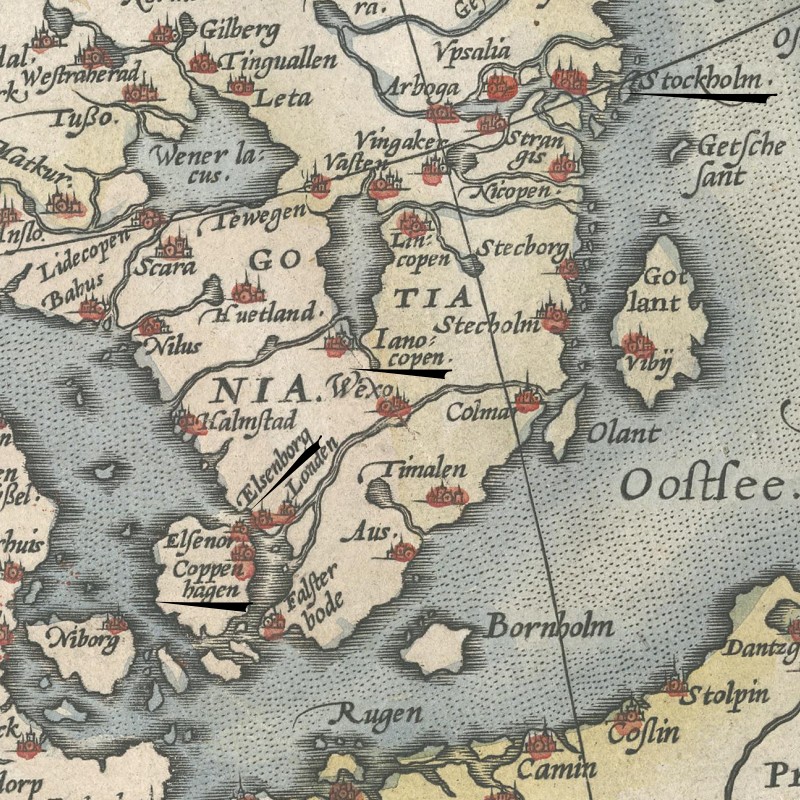
Sweden and Denmark around 1570, with Samuel Kiechel’s main stops
Travelling in Denmark and Sweden during the winter months was done by horse-drawn sledges. Initially, Kiechel wrote that they hired sledges, horses and a driver. But later on the trip to Stockholm, he only mentions changing the horses. At some point, our traveller had bought a sledge without mentioning it.
Rural Accommodation
The three travellers hired two sledges to take them two miles. The road was covered in deep snow, and progress was slow. Kiechel noted that the horses already faced enough difficulties pulling an empty sledge. After covering the agreed-upon two miles, the group hired two more sledges with their drivers to carry them a further two miles.
This stop-and-start travel over short distances was likely due to the fact that none of the local sledge drivers wanted to venture too far from home during the winter months. Additionally, as Kiechel mentioned, the horses tired more quickly.
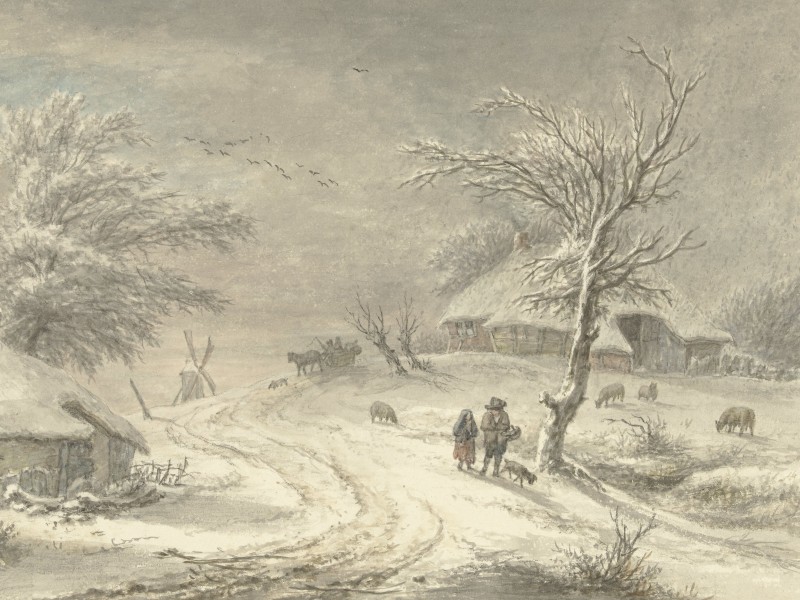
In the evening, the group arrived at a village that Kiechel called Ruy. I was unable to locate it. Sixteenth-century maps of Scandinavian countries are rare and not particularly detailed. Sparsely populated Sweden and Norway, which were still somewhat unknown in central and western Europe and generally regarded as peripheral, were not common travel destinations. Samuel Kiechel stayed in small villages and farmsteads throughout his journey from Helsingborg to Stockholm. With the added difficulty that our traveller wrote the names of places as he understood them, finding those settlements today can be challenging and sometimes impossible.
Samuel Kiechel and his companions spent the night in a peasant’s house. The accommodation was poor, with little food and only murky water to drink. Fortunately, the group carried a supply of beverages with them. At night, they had to sleep on the ground. Our traveller reports that during the winter months, not only the family sleeps in the house, but also their young farm animals such as lambs, calves, goats and pigs. The worst animals to sleep in the house were young pigs. They had a strong smell and would walk around at night, licking the faces of the sleeping people. According to Kiechel, the smell was so bad that anyone experiencing such a treat would lose all appetite.
Keeping young animals in the house during winter was not just a Swedish custom, but a common practice across all regions where winters could be severe. The houses were often small, and many consisted of just one large room where the entire family and their livestock lived. Unusual for Samuel Kiechel, he recorded some of his observations in more detail.
Swedish Farmhouses
Kiechel wrote: The houses in the provinces of Småland and Blekinge are made from the trunks of fir trees that are fitted together. The houses have four walls and are usually only one storey high. Inside, the walls of the main room are not covered with panels or plaster. The inhabitants have sealed the gaps between the tree logs with loam or cow dung. The roofs of the houses are made from wooden planks and covered with grass sods. In summer, sheep and goats are allowed to graze there. Most peasant houses have only one tiny window about a cubit long and wide in the roof. The window is covered with parchment or glass. The people living in those houses do not need more windows.
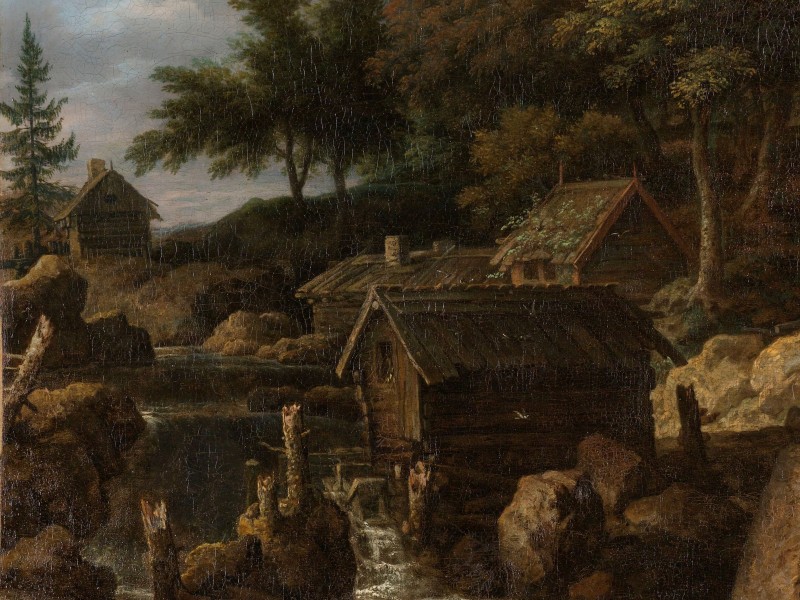
The doors of the Swedish peasants’ houses are very low, requiring people to bend down to enter. Conversely, the threshold of the doors is so high that it is not easily crossed. The tall threshold is intended to keep the young animals inside.
In the main room of the house stands a table that is usually as long as the room is wide. During the winter, this room functions as a kitchen, larder and bedroom. Instead of a stove, the houses have an oven used for heating the room. Each day, three hours before dawn, a large fire is built in the oven. This fire heats the house for the entire day. The main room becomes so warm that the woman of the house, the children and the servants — who do not need to work outside — will walk around in their shirts despite the freezing temperatures outdoors.
Regarding sleeping arrangements, Kiechel wrote that every person in the household has their own designated sleeping spot. Usually, the bed of the head of the house and his wife is beside the table. It has little bedding and is mainly made of straw. Around the oven, where it is warm, the children sleep. Infants sleep in a box made from a single piece of wood, hung with a rope from a beam in the roof. The servants sleep on benches covered with straw. Guests are required to sleep on the floor, or, if shown some courtesy, are allowed to sleep on the table.
Furthermore, Kiechel observed that young animals, such as calves, lambs, goats and piglets, also stay in the main room of the house. Dogs, cats, chickens and pigeons are not allowed inside. The young animals are kept in the middle of the room and, as mentioned earlier, they tend to lick the faces of the sleeping people. Kiechel comments that it is easy to imagine the smell of a room where people and animals live so close together, and the stench cannot escape due to the lack of windows and the narrow door. A guest opening the door will be hit by the smell and feel more fed up than after the finest meal.
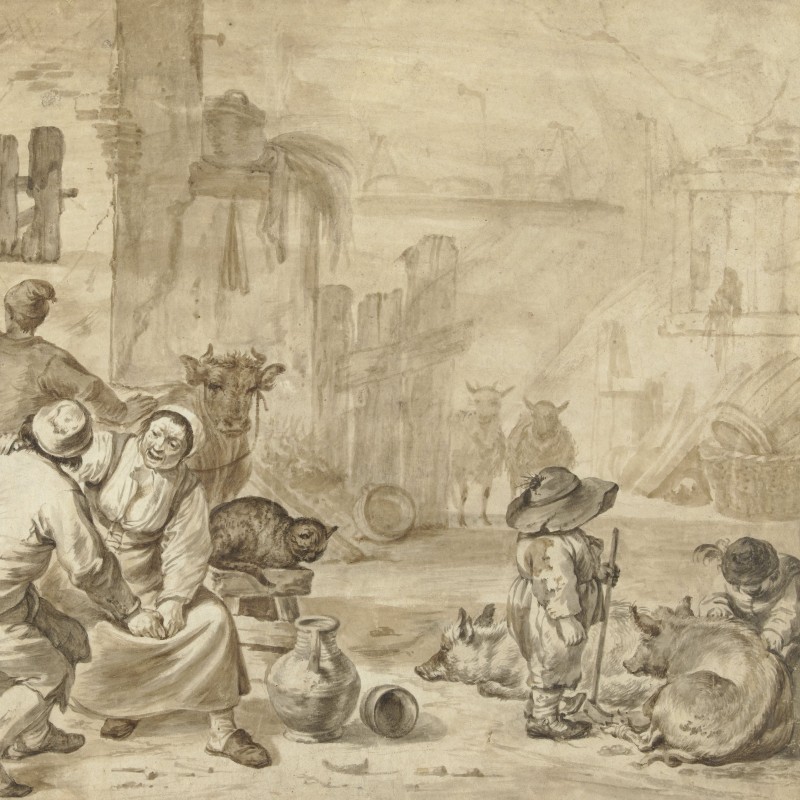
As for table manners, Kiechel wrote that the man of the house always seats himself first at the table. He sits at the head, with his wife beside him. During the meal, he will burp loudly, as will his wife and children. Our traveller assumes they do this to amuse the guests. If a guest brings enough food for the family to join, they are welcome. They will also ask guests for items such as nutmeg, cinnamon, cloves and ginger. However, if guests request something, even if they offer to pay, they will find it challenging to obtain it. A large wooden bowl serves as a drinking vessel on the table, which must be lifted with both hands.2
How to Travel in Sweden
On the morning of 10 February, the travellers pressed on with their journey. Once again, they hired a sledge and driver to take them the next two miles. The snow was so deep that it took the group five hours to cover the distance. Kiechel observed that there was little traffic in this area, so close to the border between Denmark and Sweden.
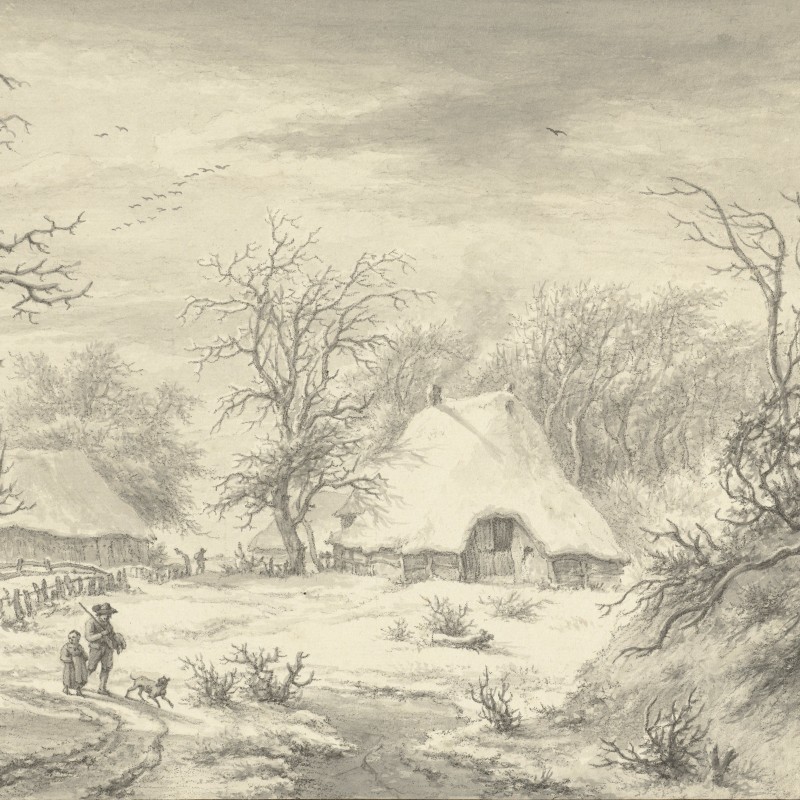
After two miles, the travellers struggled to find transport to continue. The man who had brought them there with his sledge was unwilling to go further because his horses were exhausted. The hamlet where they had stopped was on the Swedish side of the border and consisted of only three houses. The travellers decided that their best option was to pretend to be in the service of the Swedish king.
Kiechel explained that it is customary in Sweden to have certain people in each parish appointed to serve as hosts for travellers. These parishes and, consequently, the hosts, are roughly two miles apart (according to the traveller, the length of a Swedish mile is comparable to a Swiss mile). The hosts are supposed to provide travellers with accommodation, food and drink for two ‘Rondstuckh’ per meal, which is worth about four Kreuzer.
A ‘Rondstuckh’ was presumably a Swedish coin, and Kreuzer was a general term for smaller coins used in southern Germany. Kiechel often used familiar coinage to estimate the value of coins from the countries he visited.
He also wrote that the hosts are supposed to help travellers reach the next parish by providing horses and a sledge, if available. Again, this would cost a traveller two ‘Rondstuckh’. However, a person travelling in the service of the king and bearing the king’s coat of arms must be supplied with food, drink, horses and a sledge by all peasants, without any payment. In contrast, foreign travellers are often charged double and would only receive transport if it suited the host. Kiechel noted that he experienced this more than once.
Samuel Kiechel does not comment on whether their impersonation as Swedish servants was successful. But he wrote that they received three weak horses and two sledges after begging for a long time. The travellers harnessed the two weakest horses to one sledge, and the third horse had to pull the other sledge alone.
On Thin Ice
By the time the travellers finally left the hamlet, it was already late in the day, and the road was terrible. While crossing a wide ditch, the two horses pulling one of the sledges broke through the ice and stood up to their bellies in the water. The sledge tipped over and fell into the water along with one of Kiechel’s companions and their luggage. Our traveller was lucky, as he was not on the sledge but walking alongside it.
It took the three men considerable time and effort to recover the horses, sledge and luggage from the water. Meanwhile, night fell, and they still had a long way to go. Samuel’s companion, who had fallen into the water, was not feeling well. He was wet, and it was very cold.
Eventually, the group reached a village called Onolzböckh in the Swedish province of Småland during the night. Once again, I was unable to find this place.
The travellers stayed in the house of the local parish priest. Kiechel noted that travellers in Sweden who want food and drink are advised to seek accommodation with the local reeve or parish priest. Although their houses were not inns, they did not turn people away. The parish priest was very welcoming, providing food, drink and a place to sleep. He also showed them a special, heated room where they could dry their wet belongings.
As one of the few moments in the journal where the traveller offers some insight about himself, Samuel Kiechel wrote that he did not speak Swedish and therefore could not converse with the priest. But learning Latin had been part of his education. He decided to try it, but mentioned that he had not used Latin for ten years. Naturally, he found it somewhat challenging to communicate in the language.
Regarding local customs, our traveller wrote: If guests wish to be welcomed into a Swedish home, they must give the woman of the house nutmeg, cloves, cinnamon, ginger or similar items. For children, he recommends bringing brass rings, mirrors, knives, necklaces and other small trinkets.
To Jönköping
Kiechel and his companions continued their journey the following day (11 February). They travelled through desolate, mountainous terrain. Whenever they saw a village or farmstead, it was typically situated in a wilderness or within a gap between mountains. The inhabitants of these places rarely encountered foreigners. During the day, the travellers passed three staging posts where they changed horses.
From the context of Kiechel’s narrative, these staging posts were likely the appointed hosts mentioned earlier, who supplied travellers with food, drink and transport. Referring to them as staging posts, ‘posten’ in the journal, was probably due to Kiechel’s familiarity with the postal stations in Germany that offered similar services.
At the third staging post, the group received the final available horses. The peasant who provided the animals sent two young boys to lead them back once they had reached the next location. Kiechel noted that the boys were only seven or eight years old.
The group had not yet reached their destination when night fell. They became lost in the darkness and spent two hours travelling through the night, attempting to find the road again. Eventually, they arrived at a small hamlet featuring a mill and three or four farmhouses. One of the locals was a host, but he proved very reluctant to assist due to the travellers’ late arrival. According to Kiechel, the hamlet was called Abüe. The group stayed overnight.
The next day, Samuel Kiechel and his companions passed five staging posts. A pathway carved into the deep snow by other sledges allowed for quicker progress than the previous day. Whenever possible, frozen lakes were used as roads. At the last stop, where the group changed horses, night was already falling. However, the three men still had to travel another three miles across a high mountain.
Kiechel had learnt that in this area, Swedish troops had taken position when the Danes attempted to enter the country. Tall fir trees grew here, and the Swedes had cut them down to close the pass and block the way of the Danish troops. The Swedes fortified their barricade with guns and other weapons.
This comment likely references the Northern Seven Years’ War (1563-1570) and the exhausting, inconclusive skirmishes between the Danish and Swedish armies.
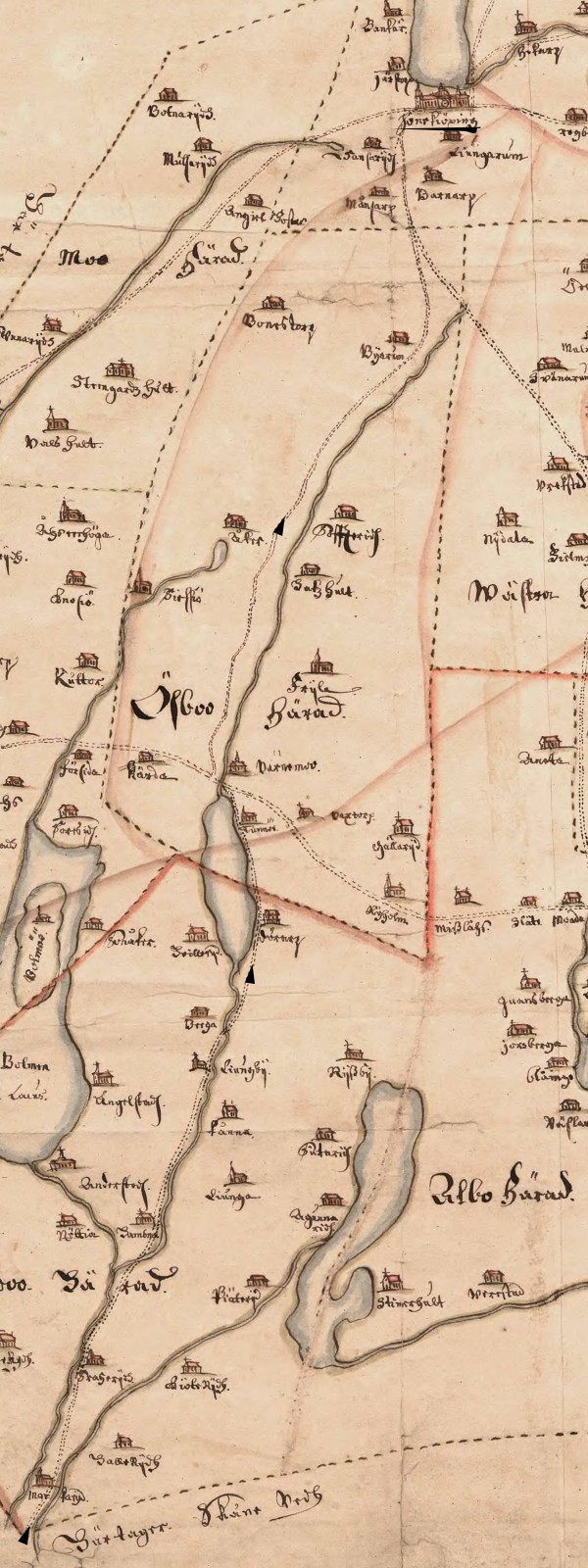
The likely route Samuel Kiechel took from the Danish border in the south to Jönköping in the north
The descent down this mountain was dangerous. The sledges were travelling at a very rapid pace, and the road was a hollow lane with no option for the horses to leave the track and slow down. Eventually, the travellers arrived in the town of Jönköping at midnight. Jönköping is a large town in the Swedish province of Småland, situated on the southern tip of Lake Vättern.
Illustrations & References
All images are in order of appearance with links to sources on external websites:
- van der Neer, Aert, Winter Landscape near a Town with Kolf Players and Horse-Drawn Sleighs, c. 1650 – c. 1655; Rijksmuseum Amsterdam.
- Ortelius, Abraham, Theatre of the World, Antwerp 1587, fol. 90v; Library of Congress.
- van Drielst, Egbert, Wintergezicht te Exloo, 1755-1818; Rijksmuseum Amsterdam.
- van Everdingen, Allaert, Swedish Landscape with a Waterfall, 1650 – 1675; Rijksmuseum Amsterdam.
- Saftleven, Cornelis, Stalinterieur met acht personen, 1651; Rijksmuseum Amsterdam.
- van Drielst, Egbert, Winterlandschap, 1806; Rijksmuseum Amsterdam.
- Anonymous, Småland och Öland, generalkartor; Riksarkivet Stockholm.
- Die Reisen des Samuel Kiechel aus drei Handschriften, K. D. Haszler (ed.), Stuttgart 1866, p. 59; Bayerische Staatsbibliothek. ↩︎
- Ibid., pp. 81-83. ↩︎